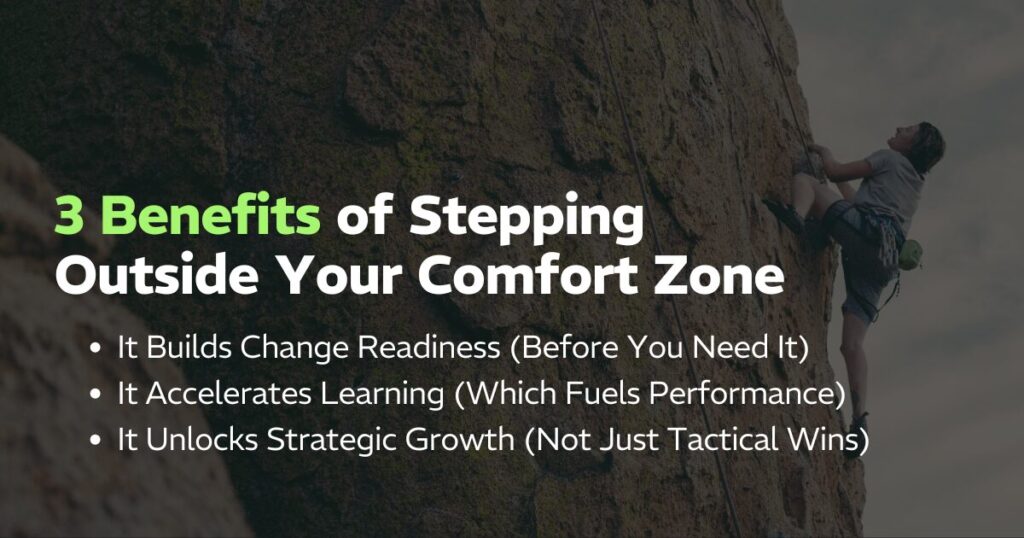Discomfort is often the catalyst for growth.
And yet, most of us spend an extraordinary amount of time trying to stay safe and comfortable—repeating what’s worked and sticking to familiar routines.
That’s a mistake. In May 2024, the National Federation of Independent Business (NFIB) Uncertainty Index reached its highest levels since November 2020. Change and uncertainty are constant. And as technology is evolving and customer expectations are shifting, the strategies that got us results in 2018 won’t cut it in 2025 and beyond.
The best leaders and the most effective commercial teams are wired and ready for change. They’ve conditioned a growth mindset with the understanding that the evolution required for success is going to be uncomfortable. The question is—are you?
3 Benefits of Stepping Outside Your Comfort Zone
Stepping outside your comfort zone isn’t about dramatic reinvention. It’s about building the habit of doing unfamiliar things—trying, testing, stretching—especially when it’s uncomfortable.
And it’s not just good for business. A 2023 study by researchers from the University of Haifa and Stanford found that people who deliberately pursued new, challenging experiences outside their routine reported higher life satisfaction—especially when those actions helped others.
If you want to grow—yourself or your team—you need to make discomfort part of your rhythm. Here are three ways you can move people into the stretch zone where meaningful growth happens. Stepping outside of your comfort zone isn’t just a mindset shift. It creates real advantages—for individuals, teams, and the businesses they power.
It Builds Change Readiness (Before You Need It)
If the last few years have taught us anything, it’s this: waiting for disruption to force change is a losing strategy.
The most successful sales teams we see today didn’t pivot overnight. They built the habit of growth before the pressure was on. They invested in new skills. They tested bold ideas. They learned how to evolve while things were still stable. So when the market shifted, they didn’t scramble. They activated.
That’s the benefit of operating just beyond your comfort zone. You’re not reacting to change. You’re already ready for it.
It Accelerates Learning (Which Fuels Performance)
There’s a reason discomfort and learning tend to show up at the same time. When you’re doing something new, stretching into unfamiliar territory, or rethinking the way you’ve always done things, you’re learning. And in sales, that learning curve translates directly into competitive advantage.
Take AI. Sales teams who are leveraging it effectively today didn’t wait until it was mainstream. They started experimenting early. They leaned into the learning. They asked the awkward questions. Now they’re 20% more productive—and rising.
Discomfort is the cost of admission to staying sharp.
It Unlocks Strategic Growth (Not Just Tactical Wins)
Comfort tends to keep us focused on efficiency: doing what we know how to do, a little faster or a little better.
But real, scalable growth? That requires a different kind of thinking.
When we step into discomfort, we start seeing things differently. We reframe risks as opportunities. We notice gaps in the market. We find ways to create value that others miss—because they’re too busy protecting what they already have.
That’s where innovation lives. Not in the familiar, but in the fringe. And even a small mindset shift—like the No Complaining Challenge—can rewire how you lead through discomfort and turn it into forward motion.

How to Step Outside Your Comfort Zone
It’s one thing to talk about stepping outside your comfort zone. It’s another thing to operationalize it—especially when you’re responsible for leading others.
In moments of uncertainty, most teams look for guardrails. They default to what’s known. But the best leaders resist that pull. They create space to stretch, even when the outcome isn’t guaranteed. They normalize experimentation. They make room for mistakes—and momentum.
Because sustained growth doesn’t come from playing defense. It comes from building a team that knows how to move forward, even when the path isn’t perfectly clear.
Try these three moves to lead yourself (and your people) into a stretch zone that drives real results.
Pair Your Business Plan With a Development Plan
If you’re only measuring revenue and performance, you’re only tracking half the story.
The real fuel for future growth is skill development. And yet, most organizations treat training as an event rather than as a rhythm. Something that happens once a year, instead of something that’s woven into the fabric of how the team operates.
You can change that by build a development plan that runs parallel to your business plan. Make it measurable. Make it visible. Track the capabilities your team is building the same way you track pipeline and quota.
And then reinforce it. Create space for reps to share learnings. Build peer-to-peer coaching into your weekly cadence as part of a continuous performance management model.
When the learning never stops, neither does the personal and professional growth.
Hitting numbers is important. But sustainable growth comes from sharpening your skills. Make learning part of your operational rhythm—not an afterthought.
Reframe Risk as Opportunity
We’re wired to avoid risk. But not all risk is created equal.
The most effective leaders aren’t reckless—they’re resourceful. They know that periods of volatility can create a window for bold moves. And they’ve trained themselves (and their teams) to look for those moments.
Want to future-proof your strategy? Start by asking this question regularly: Where’s the opportunity that others aren’t seeing—because they’re too focused on staying safe?
Maybe it’s adopting a new tool that’s still in beta. Maybe it’s testing a pitch that feels uncomfortably ambitious. Maybe it’s rethinking how you go to market entirely. Whatever it is, the teams that learn to move with purpose in uncertainty don’t just survive change. They leverage it.
Normalize the Stretch Zone
Encourage your team to try the hard thing, ask the awkward question, pitch the bold idea. Celebrate progress, not just perfection.
Discomfort is easier to navigate when it’s expected. If you want your team to get comfortable being uncomfortable, you have to model that. Talk about your own learning journey. Share the bold ideas that didn’t pan out. Highlight experiments that didn’t deliver perfect results—but taught something valuable.
Most importantly, you want to reward effort, not just outcomes. Recognize the rep who pitched the unconventional solution. Celebrate the teammate who asked the hard question in the client meeting. Publicly reinforce the behaviors that stretch people forward—even when they’re not tied to a big win (yet).
When you do that, discomfort becomes a signal of progress—not a red flag.

Ready to Step Forward?
Discomfort isn’t a problem to solve—it’s a signal you’re doing something that matters and preparing for the future — whatever it may bring.
And if you want to lead a team—or a business—that’s ready for the future, you have to start building that muscle now.
So I’ll leave you with a simple challenge: What’s one thing you’ve been avoiding because it’s uncomfortable?
Do it.
Make the call. Pitch the idea. Try the new tool. Ask for the feedback.
Start small if you have to. But start. When you build discomfort into your routine, you’re not just preparing for the next challenge. You’re creating the conditions for sustainable, resilient, meaningful growth. And in a world that won’t stop changing, that’s the edge that matters most.










